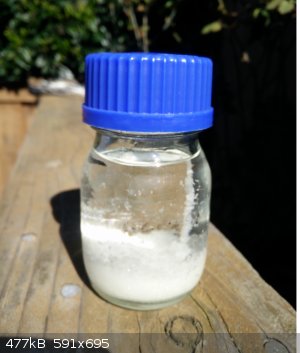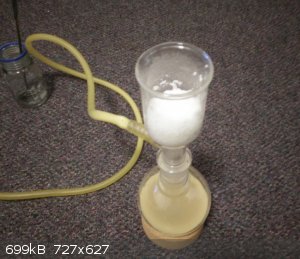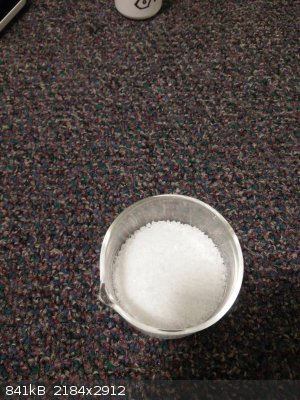Cryolite.
Hazard to Others
  
Posts: 269
Registered: 28-6-2016
Location: CA
Member Is Offline
Mood: No Mood
|
|
Synthesis of Benzopinacol
Benzopinacol is an interesting compound with a very interesting synthesis. It is prepared via the radical pinacol coupling of benzophenone. Unlike a
standard pinacol coupling which uses a metal reductant (usually magnesium), the hydrogen donor in this reduction is simple isopropanol. When exposed
to ultraviolet light, benzophenone degenerates to a triplet diradical state. This diradical abstracts a hydrogen atom from a solvent isopropanol
molecule, forming a stabilized benzhydrol radical and an isopropanol radical. This isopropanol radical is highly reactive, and it quickly donates a
hydrogen atom to another benzophenone molecule to become acetone. Eventually, two benzhydrol radicals will collide and dimerize, forming our
benzopinacol product. The experimental procedure for this reaction was taken from Org. Synth. 1934, 14, 8, and was followed on a 0.1x scale.
Isopropyl alcohol was dried by the method of Gilson in JACS 54 1445 (1932) as posted on this forum. To approximately 200 ml of 91% isopropyl alcohol
(concentrated by treating 70% IPA with salt), 15% by mass sodium hydroxide was added. This was allowed to rest with occasional agitation for 10
minutes, and then the lower lye layer was separated off. This process was repeated twice more, and after distillation about 140 ml of substantially
dry isopropyl alcohol was obtained, coming over almost entirely at 82 C.
To 85 ml of dry isopropyl alcohol in a 100 ml resealable glass bottle, 15 grams of benzophenone was added. One drop of glacial acetic acid was added
to scavenge any basic materials which would catalyze decomposition of product. The mixture was then heated to dissolve the benzophenone. Once all of
the crystals had dissolved, the bottle was placed on a windowsill for a month to allow the reaction to take place. (Although the reference states that
eight to ten days of exposure to bright sunlight suffice, it has rained more days than not here, and an excess of light should not hurt it.) After a
month, a thick white precipitate of crystals had formed. The solution is chilled in the freezer, and the crystals are filtered on a fritted funnel.
The product is washed with cold isopropyl alcohol and air dried overnight to yield 14.04 grams of a fine microcrystalline powder. A melting point was
not taken, as it is intended for further processing to benzopinacolone. However, a crude test was performed. The only materials which could
concievably result from the reaction are benzophenone, benzhydrol, and benzopinacol. As only the latter melts above 100 C, a small spatula of product
was added to some boiling water. As the crystals did not dissolve or melt, it was concluded that the product is benzopinacol.
A second batch was made in the same way with the isopropyl alcohol from the first batch. This proceeded in much the same way as the first batch,
except this time the crystals formed were larger and cubic in shape (presumably due to less disturbance of the bottle and warmer temperatures). These
were filtered off and dried as before. The yield of second batch crystals was 14.46 grams.
Pictures below. As I lost the pictures of the first batch, the second batch is illustrated below. Note that the isopropanol filtrate should be clear,
but it is a cloudy yellow due to my fritted funnel being somewhat dirty. This will be redistilled before any further use.

Picture of bottle after a month in the sun

Filtration

Final crystalline product
Incidentally, does anyone know if a Bayer-Villager type oxidation would work on benzopinacolone?
[Edited on 12-3-2017 by Cryolite.]
|
|
|
Texium
Administrator
       
Posts: 4508
Registered: 11-1-2014
Location: Salt Lake City
Member Is Offline
Mood: PhD candidate!
|
|
Excellent! This is something I should try, being as I have benzophenone and absolute isopropanol sitting around already. Though I don't have any use
for it currently, it's always nice to have more compounds on hand.
|
|
|
CuReUS
National Hazard
   
Posts: 928
Registered: 9-9-2014
Member Is Offline
Mood: No Mood
|
|
I don't see why not.You would most likely get benzoic acid trityl ester
|
|
|
Cryolite.
Hazard to Others
  
Posts: 269
Registered: 28-6-2016
Location: CA
Member Is Offline
Mood: No Mood
|
|
Note that benzopinacolone is the product obtained by pinacol rearrangement of benzopinacol. It is alternatively called 2,2,2 triphenyl acetophenone,
or trityl phenyl ketone.
|
|
|
JJay
International Hazard
    
Posts: 3440
Registered: 15-10-2015
Member Is Offline
|
|
Oh right, you want to do it on benzopinacolone, not benzopinacol... yeah, that should work fine.
|
|
|
|